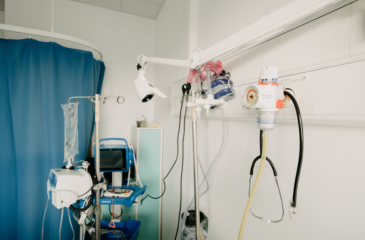This post is part of our "Bioethics in Focus" series featuring experts from the Center for Bioethics community.
“For several nights in succession, my nurse would enter my room sometime around 11:00pm, awaken me, then start on her tasks: check my vitals, check my blood sugars, check, measure, and empty the drainage from my various tubes. She would then inject me with insulin, then with blood thinner, moving me about looking for fresh areas of injection. She would hang my antibiotics, and, if the timing was right, change my IV fluids. Then, she would give me four pills to swallow. After about an hour, these tasks applied to me while I was in a groggy state of half-sleep, she would ask almost cheerfully, ‘Is there anything I can do for you?’ I would always shake my head, ‘No.’ A couple of hours after this, an aide would come and again measure my vitals, and then a couple of hours after that measurement, someone from the lab would come to draw my blood.”
A professor of bioethics and general internal medicine at the U of MN, Dr. John Song wrote these reflections about his own experience with pancreatic cancer. His point in doing so was to ask for whom all these sleep-depriving measurements were for, when he knew what he -- the patient -- needed most was a good night’s sleep.
Analogously, the story of our friendship is encapsulated by the same problem -- that what matters most is often not measured by what is most easily measurable. When mattering defies the logic of measurement, one can be greater than ten: We had been casual friends for more than ten years, but I regard the relationship we formed in his final year to be one of the most meaningful friendships I will ever have. When he wasn’t bedridden, we would meet at a French bakery near his house – one professor of bioethics and one professor of business ethics, on the pretense of initiating a research project to develop measurements that matter in a healthcare system in which performance measures were too often misaligned with the moral purpose of patient care. He wondered, “Whom is this for?”
One way to interpret his question is to wonder about which patients healthcare exists to serve. This is the question that the preponderance of John’s work, on healthcare for underserved populations, including homeless persons and prisoners, aimed to answer. Lacking social position and economic resources, such people are not typically counted by the healthcare system. However, John’s pioneering research demonstrated that, granted access, they would accept care from a system that rejected them. For example, “people living in dire economic and social situations will complete an AD [advance directive] when offered the opportunity” (Song et al., 2008).
However, as it pertained to his own care as a patient, “I was someone’s patient to examine, someone’s body to inject Lovenox into, someone’s billing to code, an institution’s length of stay to measure.” It seemed to him that the well-intentioned nurse and lab technician disrupted his sleep not to serve his particular needs as a patient but rather to preserve the perceived needs of the institutional complex. In this context, his question concerned whose ends it should be the purpose of healthcare to serve.
John diagnosed the disparity between the treatment he received and his needs as a patient as a misalignment between economic goals – hence, he sought out a business ethicist – and ethical ones – the reason for being of healthcare. For example, the design of healthcare implicitly reflects decisions made abstractly, about how many resources should be allocated to achieve healthcare goals. In conventional economic language, the hospital valued the return on its investment in care by measuring a reduction in patient mortality. However, although John desired not to die, his ethical well-being as a human patient was profoundly more complex and concrete than can be expressed by a simple measure of whether or not he died on a particular visit to the hospital.
Before his terminal diagnosis, John explained to me his experience of preparing at the same time for two realities: one in which he recovered fully, resumed his career as a provider and professor who was no longer a patient, saw his daughters off to college, traveled with his wife as private citizens and global volunteers, and someday welcomed grandchildren into their home. The other reality was that clean scans, which had allowed him to live three months at a time hopeful about such a future, would cease to be clean, that the cancer had metastasized. These two scenarios were mutually exclusive. Were economic and ethical healthcare goals similarly incompatible?
In healthcare, efficiency outcomes are often expressed as an objectively measurable function of economic resources (e.g., money, or time which is seen as reducible to money) per unit served (e.g., patients or population members) or utilized (e.g., beds). Patient outcomes are usually expressed as occurrences of objectively identifiable events (e.g., deaths, readmissions) per capita and are uniform among patients. They are “hard” (or, to use the more technical term, “objective”) in the sense that they can be determined from externally verifiable data as opposed to psychological states and idiosyncratic preferences of particular patients. Patient-centered outcomes, by contrast, are typically “soft” – or subjective – and situational. Among them, health-related quality of life metrics have not been thoroughly tested and so are less reliable and often disease- and population-specific (Centers for Disease Control and Prevention, 2018).
In one widely relied-upon resource for hospital quality, the Centers for Medicare and Medicaid (2020) use seven outcome measures, weighted by importance: Mortality (22%), Safety of care (22%), Readmissions (22%), Patient experience (22%), Effectiveness of care (4%), Timeliness of care (4%), and Efficient use of medical imaging (4%). In our brief discussion of this study, and in notes John left behind, he characterized readmissions, timeliness, and imaging efficiency as efficiency (economic) outcomes, whereas mortality, safety, patient experience, and effectiveness were patient (ethical) outcomes. However, among those patient outcomes, arguably only patient experience is patient-centered, and it is subjective.
Mortality, on the other hand, is an objective patient outcome that is not necessarily patient-centered. If patient survival is a valuable goal, then measuring and rewarding a decrease in patient mortality will motivate behaviors to extend patient life. And, as John himself experienced, living longer was a worthwhile aim. An expert in end-of-life care, he well recognized the social costs of overinvesting in expensive treatments to preserve quantity of life at the expense of individual and systemic quality of life. Yet, as a dying patient, he wanted to survive – for his family, and for himself. He was already enduring constant physical pain – sometimes manageable, but not eliminable – when he said to me that he would be willing to stay on extended life support if his wife and children needed more time to say goodbye.
Every procedure carried with it the uncertain promise of prolonged survival which, until his terminal diagnosis, might have revived hopes of a “normal” life span. Yet, every procedure also involved the risk that it could be his last. After he was given just months to live, that might mean cruelly stealing from him his last few weeks, days, or even hours. None of John’s willingness to permit the healthcare system to extend his life, however, obviated the eventuality of palliative care and hospice over continuing surgery, chemotherapy, and life support. Once he and his family opted for that path, the systemic goal of preventing patient mortality was no longer consistent with John’s goal as a patient.
John diagnosed the shortcomings in his care to be in significant part a consequence of a healthcare institution measuring the wrong things – not the failings of his individual caregivers. In one well-documented irony, the American healthcare system that is so obsessed with efficiency is remarkably inefficient. In another irony, even though many healthcare institutions today claim to offer patient-centered care, patient outcomes take priority over patient-centered outcomes. This is not to say that individual healthcare professionals are not focused on their patients, but rather that the institutional policies and decisions that constrain their behaviors are driven by efficiency and patient outcomes – such as checking vitals on a schedule that suits the nurse’s obligation to oversee a certain number of beds per shift rather than a schedule that serves each individual patient’s care priorities.
We speculated, at our bakery table, about the reason for the incommensurability between economic and ethical goals. It was not that anyone would assert that patient-centered outcomes were unimportant. Rather, it was that the measurability of patient outcomes gave them unmerited priority simply because they had the virtue of appearing objective. In other words, what is measured gets disproportionate attention because it is measurable.
As a scientist, John doubted we could or should convince medical doctors, policymakers, and organization scientists to give up measurement altogether. An important part of the reason objective measures rank higher in the measurement of healthcare is that they are uncontroversially measurable. Subjective measures are always vulnerable to the charge of being “soft.” Not only is each particular data point dependent upon the whims of human emotion and circumstance, but collective data may be influenced by the cultural context in which they are collected, the wording of the questions, the time period for answering, and so on.
We felt we were on the brink of a breakthrough in theory, if not yet in practice. We had determined what extant healthcare performance measures seemed to be missing. Objective, institution-centered measures like readmissions prioritized efficiency over effectiveness. Subjective, patient-centered measures like patient satisfaction prioritized perception over reality, as did subjective, institution-wide measures of patient experience. These measurement types comprise three of the four boxes of the 2x2 matrix below.
What we sought to conceptualize was a system of objective, patient-centered measures that would satisfy medical scientists’ proclivity for privileging verifiability while respecting patients’ personal and sometimes idiosyncratic outcome preferences. In other words, we were not seeking to eliminate measurement in healthcare altogether but rather to develop additional measures that did a better job of balancing economic (efficiency) and ethical (patient-centered) goals. I have drawn the suggested examples in that elusive fourth box from John’s research with homeless patients and his advocacy for higher education to teach students not only how to live but how to die (Ratner & Song, 2002):
| Objective | Subjective |
|---|---|
| Institution Outcomes: Efficiency, e.g., bed occupancy rate, patient readmissions, patient mortality rate | Institution Outcomes: Perceived institutional effectiveness, e.g., aggregate patient experience |
Individual Outcomes: Objective, patient-centered measures, e.g.:
| Individual Outcomes: Perceived patient-centered effectiveness, e.g., individual patient experience |
Sadly, our conversations ended prematurely. Oftentimes, we would digress into stories about our wives and children, work, and literature, particularly how the uncertainty of his condition made every encounter – with human beings, the needs of our world, and the beauty within it – that much more precious and precarious. He would order a slice of coffee cake so large that it accentuated how slight pancreatic cancer had rendered his frame. As if to challenge the measurable nutritional prescriptions of his profession, he prioritized the intangible gastronomic pleasure that awaited. Besides, he joked, he needed to fill his stomach, so he would not disappear altogether.
References
- Centers for Disease Control and Prevention. 2018. Health-related quality of life. Retrieved from https://www.cdc.gov/hrqol/index.htm.
- Medicare.gov. Hospital compare. 2020. Retrieved from https://www.medicare.gov/hospitalcompare/search.html.
- Ratner, E.R., & Song, J.Y. 2002. Education for the end of life. Chronicle of Higher Education, 48(39), B12.
- Song, J., Wall, M.W., Ratner, E.R., Bartels, D.M., Ulvestad, N., & Gelberg, L. 2008. Engaging homeless persons in end of life preparations. Journal of General Internal Medicine, 23(12), 2031-2036.



